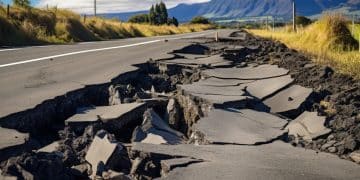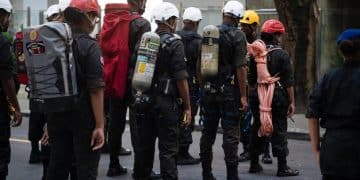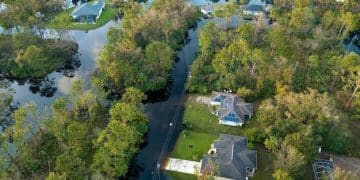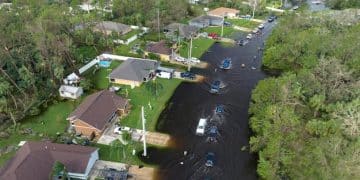Understanding Disaster Alerts: Your Guide to US Emergency Preparedness
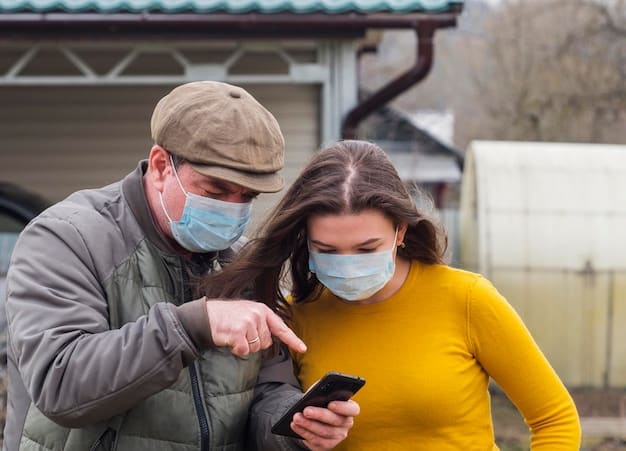
Understanding Disaster Alerts is crucial for US residents to stay informed and safe during emergencies, enabling timely action and minimizing potential harm.
Are you prepared to face a disaster? **Understanding Disaster Alerts: Staying Informed During Emergencies in the US** is vital for your safety and the well-being of your loved ones. Whether it’s a hurricane, earthquake, or any other crisis, being informed can make all the difference.
Why Understanding Disaster Alerts Matters
Disaster alerts are more than just notifications; they are lifelines. In critical situations, these alerts provide timely information that can guide your decisions and actions. Understanding their purpose and how they function is essential for ensuring your safety and preparedness.
The Importance of Timely Information
In any emergency, time is of the essence. Disaster alerts deliver information directly to you, providing instant updates and instructions that can help you take immediate action. This can range from evacuating an area to seeking shelter or preparing for potential hazards.
Staying Informed: A Responsibility
While emergency services work tirelessly to protect communities, individual awareness and preparedness are equally important. By staying informed through official disaster alerts, you become an active participant in your own safety and the safety of those around you.
- Enhanced Safety: Knowledge is power, and being informed allows you to make decisions that can significantly reduce your risk.
- Community Resilience: Prepared individuals contribute to a more resilient community capable of withstanding disasters.
- Effective Response: Understanding alerts ensures you respond appropriately, minimizing confusion and panic.
Understanding disaster alerts is not just about receiving notifications; it’s about being prepared, informed, and ready to act when emergencies strike. This knowledge empowers you to protect yourself and contribute to the overall resilience of your community.

Types of Disaster Alerts in the US
The United States employs a multi-faceted approach to disaster alerts, utilizing different systems to ensure comprehensive coverage and timely delivery of critical information. Each system has its own strengths and is designed to reach specific audiences through various channels.
Wireless Emergency Alerts (WEA)
Wireless Emergency Alerts (WEA) are short emergency messages sent to mobile phones in affected areas. These alerts are targeted and designed to grab your attention immediately, often accompanied by a unique sound and vibration. WEA messages are used for the most critical alerts, such as imminent threats, AMBER Alerts, and Presidential Alerts.
NOAA Weather Radio
The NOAA Weather Radio is a nationwide network broadcasting weather and hazard information 24/7. It’s a reliable source for staying informed about weather-related emergencies, providing detailed forecasts, warnings, and other critical updates.
Local Alert Systems
Many local communities have their own alert systems designed to provide tailored information relevant to specific regions. These systems often utilize a combination of text messages, email alerts, and social media updates to keep residents informed.
- WEA: Delivers urgent alerts to mobile devices.
- NOAA Weather Radio: Offers continuous weather and hazard information.
- Local Systems: Provides community-specific alerts.
Being aware of the different types of disaster alerts available in the US ensures that you receive critical information through multiple channels. This redundancy is vital for staying informed and prepared during emergencies.
How to Sign Up for Local Alerts
While national systems like WEA and NOAA Weather Radio provide broad coverage, local alert systems offer more specific and timely information relevant to your community. Signing up for these alerts is a crucial step in enhancing your preparedness.
Researching Available Systems
Begin by researching the local alert systems available in your area. This information can typically be found on your city or county’s official website. Look for emergency management or public safety departments, which often manage these alert systems.
Registration Process
Once you’ve identified the available systems, follow the registration process. This usually involves providing your contact information, such as your phone number and email address. Some systems may also allow you to specify the types of alerts you wish to receive.
Customizing Alert Preferences
Many local alert systems offer customization options, allowing you to tailor the alerts to your specific needs. Consider setting preferences based on the types of hazards most relevant to your area, such as severe weather, public health emergencies, or public safety incidents.

- Research: Identify the local alert systems in your area.
- Register: Provide your contact information to sign up for alerts.
- Customize: Tailor your alert preferences to match your needs.
Signing up for local alerts is a proactive way to stay informed about potential hazards in your community. By taking this simple step, you can ensure that you receive timely and relevant information that can help you take appropriate action during emergencies.
Understanding Alert Levels and Terminology
Disaster alerts often use specific terminology and levels to convey the severity and urgency of a situation. Understanding these terms is essential for interpreting alerts correctly and taking appropriate action.
Decoding Alert Messages
Alert messages typically include key information such as the type of hazard, the affected area, and recommended actions. Pay close attention to these details to understand the specific threat and how it may impact you.
Common Terminology
Familiarize yourself with common terminology used in disaster alerts, such as “Watch,” “Warning,” and “Advisory.” A “Watch” indicates that conditions are favorable for a particular hazard, while a “Warning” means that a hazard is imminent or occurring. An “Advisory” is issued for less serious conditions that may still pose a risk.
Levels of Urgency
Disaster alerts often include indicators of urgency, such as “Immediate Action Required” or “Prepare for Possible Impact.” These indicators help you prioritize your response and take the necessary steps to protect yourself and others.
Understanding the terminology and levels of urgency used in disaster alerts ensures that you can quickly assess the situation and take appropriate action. This knowledge is crucial for making informed decisions and staying safe during emergencies.
Preparing a Disaster Plan
Receiving disaster alerts is just one part of being prepared. Creating and practicing a disaster plan is equally important. A well-thought-out plan ensures that you and your family know what to do when an emergency strikes.
Developing a Family Plan
Start by developing a family disaster plan that outlines specific roles and responsibilities for each member. This plan should include evacuation routes, meeting points, and communication strategies.
Assembling an Emergency Kit
Prepare an emergency kit with essential supplies such as food, water, first aid supplies, flashlights, and a battery-powered radio. Store the kit in an easily accessible location and ensure that everyone knows where it is.
Practicing Drills
Regularly practice disaster drills to ensure that everyone understands the plan and knows how to respond in different scenarios. Drills can help identify potential weaknesses in your plan and allow you to make necessary adjustments.
- Family Plan: Outline roles, evacuation routes, and communication strategies.
- Emergency Kit: Assemble essential supplies in an accessible location.
- Drills: Practice your plan regularly to ensure preparedness.
Preparing a disaster plan is a proactive step that can significantly improve your safety and resilience during emergencies. By developing a plan, assembling a kit, and practicing drills, you can ensure that you and your family are ready to face any challenge.
Utilizing Social Media and Apps for Alerts
In today’s digital age, social media and mobile apps have become valuable tools for receiving disaster alerts and staying informed during emergencies. These platforms offer real-time updates, community support, and additional resources.
Following Official Accounts
Follow official accounts from government agencies, emergency management organizations, and local news outlets on social media. These accounts provide timely updates, warnings, and other critical information.
Leveraging Mobile Apps
Download and utilize mobile apps designed for disaster alerts and emergency communication. Many apps offer features such as push notifications, interactive maps, and real-time information sharing.
Verifying Information
While social media and apps can be valuable resources, it’s essential to verify information before sharing it with others. Rely on official sources and be cautious of unverified rumors or misinformation.
Conclusion
Understanding disaster alerts is a critical component of emergency preparedness. By knowing the different types of alerts, signing up for local systems, understanding emergency terminology, preparing a disaster plan, and utilizing social media, you can ensure that you are well-informed and ready to take action when emergencies strike. Stay safe, stay informed, and be prepared.
| Key Point | Brief Description |
|---|---|
| 🚨 Types of Alerts | WEA, NOAA Radio, and local systems keep you informed. |
| ✍️ Sign-Up Local | Register to receive hyper-local emergency updates. |
| ❗ Alert Levels | Understand ‘Watch,’ ‘Warning,’ and ‘Advisory’ terms. |
| 🛡️ Preparedness | Create a disaster plan and pack an emergency kit. |
FAQ
▼
WEA is a system that sends short emergency messages to your mobile phone, designed to alert you about critical situations like imminent threats or AMBER Alerts, ensuring you receive urgent information quickly.
▼
To sign up for local alerts, visit your city or county’s official website and look for the emergency management or public safety department, which usually manages the alert systems.
▼
A “Watch” means conditions are favorable for a hazard, while a “Warning” means the hazard is imminent or already occurring, signaling the need for immediate action to protect yourself.
▼
Your emergency kit should include essential supplies such as food, water, first aid supplies, flashlights, and a battery-powered radio, ensuring you have basic necessities during emergencies.
▼
Social media can provide real-time updates, community support, and additional resources during disasters; however, it’s essential to verify information from official sources to avoid misinformation.
Conclusion
In conclusion, understanding disaster alerts is essential for staying safe and informed during emergencies in the US. By familiarizing yourself with the different types of alerts, signing up for local systems, preparing a disaster plan, and utilizing social media, you can enhance your preparedness and protect yourself and your community.
